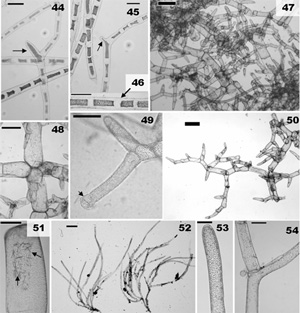
Map of Samoa

Map of Samoa |

Plate I. Figs 1-7: Cyanophytes.
|

Plate II. Figs 8-13: Ceramium spp. Figs. 8, 10, 12: Ceramium flaccidum. Fig. 8: habit, scale = 50µm. Fig. 10: nodes and internodes with elongated basipetal cortical cells (arrows), distinctive of this species, scale = 15µm. Fig. 12: unicellular rhizoid cut off from pericentral cell, scale = 50µm. Figs. 9, 11, 13: Ceramium upolense. Fig. 9: habit, scale = 200µm. Fig. 11: nodal cortication, scale = 50µm. Fig. 13: two or more rhizoids cut off from periaxials, scale = 200µm. |

Plate III.
|

Plate IV.
Figs. 20-28: Caloglossa leprieurii.
|

Plate V.
Figs. 29-33: Enteromorpha clathrata.
|

Plate VI.
Figs. 34-43.
|

Plate VII. Figs. 44-54.
|